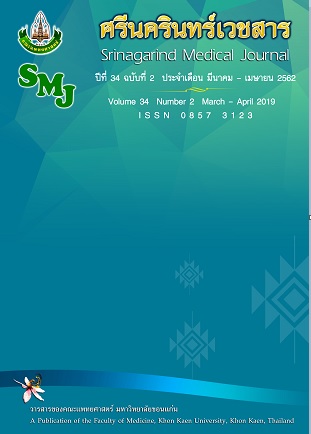Relationship between Perception of Noise Protection and the Use of Hearing Protection Devices among Stone-Mortar Workers in Phayao Province
Keywords:
Self-preventive perception; hearing protection devices; stone-mortar workersAbstract
Background and Objectives: Exposure to excessive noise for a long period of time could cause the hearing loss, especially stone-mortar making which each process could create a loud noise. Prolonged exposing to intense noise in the process could bring about the developing of hearing loss.
Materials and Methods: A cross-sectional study examined the relationship between perception of noise protection and the use of hearing protection devices among the stone-mortar workers in Phayao province. Thirty seven subjects were interviewed by questionnaire for perception of noise protection and the use of hearing protection devices. The data were analyzed by descriptive statistics and analyzed the relationship by using Chi-square test.
Results: The results showed that the stone-mortar workers consisted of 37 males (100%) with a mean (SD) age of 47.7 (12.2) years. The most stone-mortar workers were non-use of hearing protection devices (54.1%) and use of cotton balls in the ears (40.5%). The most common perception about hearing protection was at high level. Types of self-protecting devices from the noise exposure was significantly associated with the use of hearing protection devices (p<0.001).
Conclusion: Stone-mortar workers should be promoted the use of appropriate hearing protection devices.
References
2. Seidman MD, Standring RT. Noise and quality of life. Int J Environ Res Public Health 2010; 7: 3730-8.
3. National Institute of Occupational Safety and Health (NIOSH). Noise and hearing loss prevention [Internet]. 2018. [cited 2018 Oct 10]. Available from: http://www.cdc.gov/niosh/topics/noise/stats.html.
4. Thorne PR, Ameratunga SN, Stewart J, Reid N, Williams W, Purdy SC, et al. Epidemiology of noise-induced hearing loss in New Zealand. NZ Med J 2008; 121: 33-44.
5. สำนักโรคจากการประกอบอาชีพและสิ่งแวดล้อม กรมควบคุมโรค กระทรวงสาธารณสุข. รายงานสถานการณ์โรคและภัยสุขภาพจากการประกอบอาชีพและสิ่งแวดล้อม ปี 2560 [อินเตอร์เน็ต]. 2561 [เข้ําถึงเมื่อวันที่ 10 ตุลาคม 2561]. เข้ําถึงได้จาก: http://envocc.ddc.moph.go.th/contents/view/669
6. Nambunmee K, Chaengjaroen A, Songlar T, Kongkratoke S, Chunphuanhan O, Chuesuk D. Comparison of Noise-Induced Hearing Loss between Stone Processing Workers and Hotel Workers. Journal of Health Science 2016; 25: 31-40.
7. Engdahl B, Tambs K. Occupation and the risk of hearing impairment-results from the Nord-Trøndelag study on hearing loss. Scand J Work Environ Health 2010; 36: 250-7.
8. Kitcher ED, Ocansey G, Tumpi DA. Early occupational hearing loss of workers in a stone crushing industry: Our experience in a developing country. Noise Health 2012; 14: 68-71.
9. Chadambuka A, Mususa F, Muteti S. Prevalence of noise induced hearing loss among employees at a mining industry in Zimbabwe. Afr Health Sci 2013; 13: 899–906.
10. Musiba Z. The prevalence of noise-induced hearing loss among Tanzanian miners. Occupational Medicine 2015; 65: 386-90.
11. สำนักอนามัยสิ่งแวดล้อม กรมอนามัย กระทรวงสาธารณสุข. คู่มือวิชาการ เรื่อง แนวทางการประกอบกิจการที่เป็นอันตรายต่อสุขภาพ ประเภท การเลื่อย การตัด หรือการประดิษฐ์หินเป็นสิ่งของต่างๆ [อินเตอร์เน็ต]. 2555 [เข้ําถึงเมื่อวันที่ 10 ตุลาคม 2561]. เข้ําถึงได้จาก: http://env.anamai.moph.go.th/more_news.php?cid=74
12. รัตนาภรณ์ เพ็ชรประพันธ์, วันดี ไข่มุกด์, ฐิติวร ชูสง. การประเมินระดับเสียงและสมรรถภาพการได้ยินของพนักงานโรงงานโม่หินแห่งหนึ่งในจังหวัดนครศรีธรรมราช. วารสารความปลอดภัยและสุขภาพ 2558; 8: 13-23.
13. Sayler SK, Long RN, Nambunmee K, Neitzel RL. Respirable silica and noise exposures among stone processing workers in northern Thailand. J Occup Environ Hyg 2018; 15: 117-24.
14. Arezes PM, Miguel AS. Risk perception and safety behaviour: A study in an occupational environment. Safety science 2008; 46: 900-7.
15. Reddy R, Welch D, Ameratunga S, Thorne P. Development of the hearing protection assessment (HPA-2) questionnaire. Occup Med (Lond) 2014; 64: 198-205.
16. Saunders GH, Dann SM, Griest SE, Frederick MT. Development and evaluation of a questionnaire to assess knowledge, attitudes, and behaviors towards hearing loss prevention. Int J Audiol 2014; 53: 209-18.
17. Thepaksorn P, Siriwong W, Neitzel RL, Somrongthong R, Techasrivichien T. Relationship between noise-related risk perception, knowledge, and the use of hearing protection devices among para rubber wood sawmill workers. Safety and Health at Work 2018; 9: 25-9.




